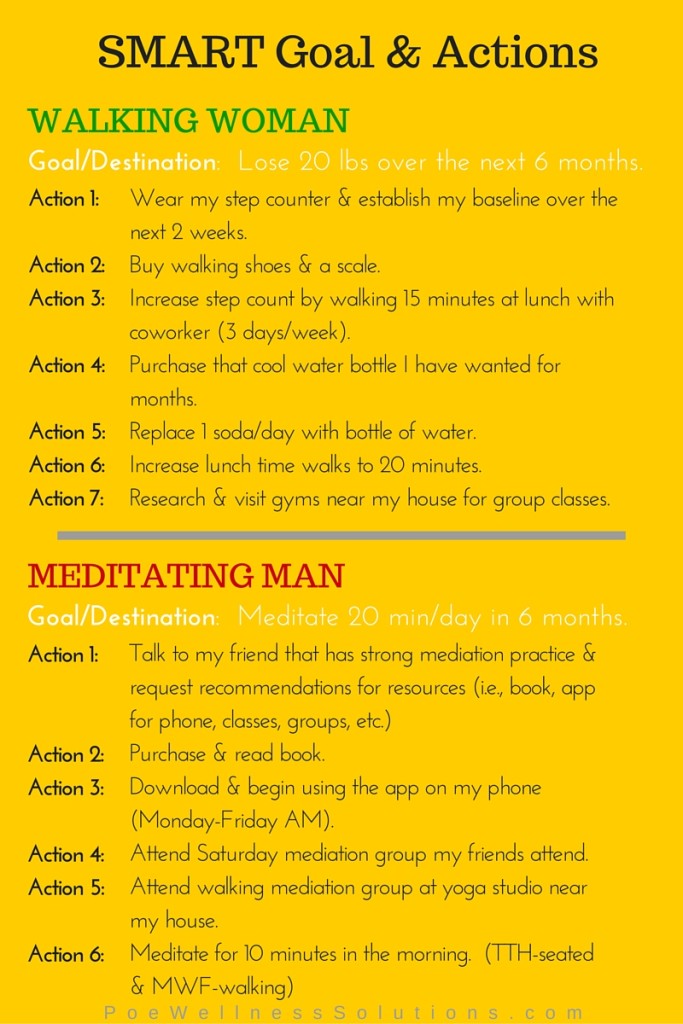Have you ever set a goal and thought, “Yes, this is it the perfect goal! I have so got this!”? Sometimes a goal makes perfect sense. It is as if the stars aligned and you are blessed by the goal setting gods (or goddesses). You know what you want and the goal is going to get you there. But wait … the goal is the destination. You get there with your actions! Yes, it may be the perfect goal but let’s dig a little deeper. Are you setting yourself up for success or discouragement? I was recently reminded of the importance of creating the right goal and being SMART about it.
if the stars aligned and you are blessed by the goal setting gods (or goddesses). You know what you want and the goal is going to get you there. But wait … the goal is the destination. You get there with your actions! Yes, it may be the perfect goal but let’s dig a little deeper. Are you setting yourself up for success or discouragement? I was recently reminded of the importance of creating the right goal and being SMART about it.
Creating The Right Goal
As a Health Coach, I am often engaged in conversations like the two below. It was mid-May and these two were gearing up for summer outings and reflecting on New Year’s resolutions.
Goal #1 ~ The Walking Woman
“What do you think I should do about my weight? My Dad got me a step counter last Christmas but I am nowhere close to the required 10,000 steps. Weight loss was my only goal this year and I have actually gained weight. Summer is almost here. Can you help?”
Goal #2 ~ Meditating Man
“My friends think that watching the news is raising my blood pressure and stress level. We all decided to meditate 20 minutes a day. I thought it was a cool idea but I only did it twice in January and none since. I want to and I have tried but I don’t really know what I am doing and it just stresses me out. What’s wrong with me?”
It is no surprise that the Walking Woman and the Meditating Man lost motivation. When setting a goal, you have to take ownership of your goal. In other words, you have to want it! Behavior change is challenging and therefore setting the right goal matters. Habits are behaviors wired so deeply in our brains that we perform them automatically. It was once believed that the wiring of the brain could not change but we now know the brain is capable of changing, adapting, and re-organizing neural pathways in response to changes in the environment, experiences, and training. The brain’s neuroplasticity allows it to form new cells and pathways … to form new habits.
Tips for Creating the Right Goal
Here are a few tips I shared with the Walking Woman and Meditating Man.
1. Set a goal that is important/makes sense to you. Yes, the Walking Woman wants to lose weight but does she like to walk? Does she attribute her weight gain to lack of exercise? Maybe the cause is a stressful job or unhappy relationship or poor nutrition. It’s like attempting to unlock a door with the wrong key. You can keep trying but you are not going to get through.
2. Set a goal in which you possess the confidence/knowledge to achieve. The Meditating Man was trying to meditate because his friends set an exciting goal. He wanted to meditate but was unsure of what to do, where to begin. Appropriate resources and knowledge about meditation techniques paired with his excitement and support from friends would create a better chance for success.
3. Set reasonable, small baby steps and work your way to the big goal. What was the Walking Woman’s current activity level? Was 10,000 steps a reasonable starting place? Did the Meditating Man ever sit still? Twenty minutes is a hefty amount of time. Be honest with your starting place. Set a long-term goal with a reasonable time frame and then create baby steps for getting there.
There are many strategies for behavior change and many opportunities to get derailed. These two individuals may be primed and ready for change but they need to start with a goal that has personal meaning and makes sense. A goal they own. Goals based on others’ ideas and expectations set a bumpy journey from day one.
Designing SMART Goals (& Actions)

Have you ever heard the mnemonic SMART for designing goals? When working in a global corporation, I was required to set SMART goals every year. UGH! I dreaded it. Now, I am a fan. If you do not like using this format when creating your goal then re-evaluate the goal. My problem at work was not the SMART part, it was creating goals that were not right for me.
There are variants but my favorites are included.
- S – Specific
- M – Measurable
- A – Action-Oriented
- R – Realistic
- T – Time-bound
SMART goal setting brings structure and trackability to your goals and actions. Instead of vague resolutions, SMART goal setting creates a verifiable path with clear milestones and an estimation of the goal’s attainabililty. Every goal or action, from smallest baby step to overarching goal, can be made SMART and as such, brought closer to reality. You decide how much you want to push yourself and modify as makes sense from week to week. (WARNING: Although I am a fan of SMART goals, I have partnered with clients stifled by the structure. There are always lessons to be learned. We modified the structure of goals and actions and found success. Tweaking is allowed and encouraged.)
Summing It Up
With a little extra effort and following the SMART plan for goals and actions, our two friends are far better prepared for success. There is a clear destination and a plan. They may not create all actions initially. Actions will be added and tweaked with time and experience. Click on the SMART Goals & Actions infographic above in order to learn how the Walking Woman and Meditating Man got smarter with their plan.
What successes and challenges have you experienced with goal setting? Feel free to share your stories.
If you would like support in creating the right goal or to learn more about working with an Integrative Health Coach, contact us. Based on your goal, lifestyle, schedule and challenges an individualized, realistic plan can be crafted and success achieved.
Set up and enjoy a Discovery Call at no charge.
